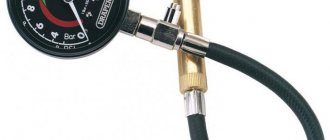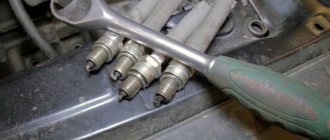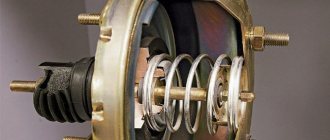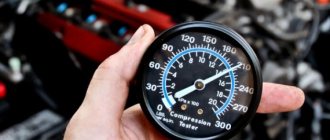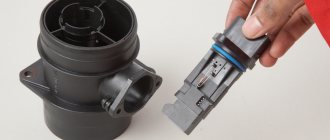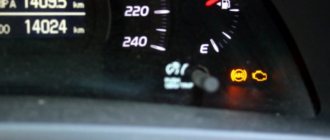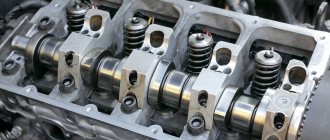Spontaneous stopping of the car's power unit can cause not very pleasant consequences, especially if the car stalls when braking while driving.
The functioning of a number of systems used to control the car depends on the operation of the power unit, and after it stops, the driver’s ability to control the behavior of the car significantly deteriorates, and accordingly, the likelihood of an emergency situation increases.
If the car stalls, when braking, the driver not only cannot accelerate to make a maneuver, the hydraulic booster (if the vehicle is equipped with one) and the brake booster also stop functioning.
At the same time, the control and braking systems of the car themselves remain operational (that is, control, in general, is preserved), but to use them you need to put in much more effort.
The driver does not always have time to adapt to the new operating conditions of the vehicle control mechanisms when the engine is not running, as a result he gets lost, which often becomes the cause of an emergency.
A little theory that is important to know
Situations when a car stalls when braking happen quite often and this does not depend on the brand of the car.
Two conditions contribute to the emergence of such a situation - the transition of the engine to minimum speed (since the gas pedal is released) and the creation of an additional load on it - the brakes, slowing down the wheels, also create a force on the transmission elements, and accordingly on the power unit.
Despite the fact that the driver stops acting on the accelerator, the power system (injection, carburetor) continues to perform its function - it prepares the air-fuel mixture in the required proportions and quantities, and then delivers it to the cylinders, due to which the engine operates under the above conditions - minimum speed and load resulting from the use of brakes.
But if the proportions of the combustible mixture are violated - it is “lean” or “rich”, then the engine simply will not be able to operate on it.
As a result, the main reason why a car stalls when braking is that the air-fuel mixture does not match the operating conditions.
Failure of VUT or hose
Each of the listed reasons due to which the car stops moving when braking should be considered in more detail. And first of all, you need to start with a possible breakdown of the VUT. A problem may also be a rupture of the connecting hose material, leading to its depressurization.
VUT is a special vacuum-based brake booster. With the help of this device, it is possible to alleviate the efforts that the car owner spends when pressing the appropriate pedal, wanting to stop the car. The device is located between the cylinder and the pedal, which is responsible for braking the vehicle.
The VUT is connected to several engine structural elements - a hose and a fuel intake manifold. Additionally, the amplifier is equipped with a membrane, damage to which can lead to engine shutdown.
In the event of a faulty membrane, if the car owner presses the brake pedal, the part will not be able to organize the necessary air vacuum, which is why the remaining gases will become part of the fuel mixture. As a result, the engine stalls. You can find the problem yourself. To do this, you need:
- Lower and raise the pedal responsible for the brake 5-6 times.
- Secure it in the lowered position.
All actions are performed with the engine not running. When everything is done, the engine will need to be started. If the part does not take the standard position and the brakes do not engage in the standard mode, it means that the membrane has indeed failed.
There is another option for checking the performance of the membrane
- After running the engine in neutral, the car owner needs to press the brake pedal and immediately turn off the engine.
- There is no need to take your foot off the pedal for 30 seconds.
If over the elapsed time the pedal does not try to take the standard position and does not resist pressing, then the VUT is working. If the opposite results are found, you will need to disassemble the braking system to continue troubleshooting.
Since the VUT is connected to a hose connecting the device to the fuel intake manifold, problems can sometimes arise in the hose itself. The rupture of the element and its depressurization cause a decrease in engine speed. As a result, the car stops abruptly, stalling.
It is noteworthy that the amplifier is usually completely replaced, and many auto repair shops are not even ready to repair this device. The replacement cost is quite high. It is not recommended to perform the procedure yourself, as there may be a risk of system breakdown.
Vacuum booster and its pipeline
The braking system itself does not interact with the engine, so it remains operational after the engine stops. But it has one component related to the power unit - a vacuum booster, which can also have malfunctions.
And despite the fact that the amplifier is combined with the engine by a relatively insignificant part - a rubber pipeline, its malfunction can affect the proportions of the mixture supplied to the cylinders.
Let's take a simplified look at the operation of the amplifier. It consists of two chambers separated by a membrane. One of these chambers (vacuum) is connected by a pipe to the intake manifold, through which air is drawn into the cylinders by pistons (they also pull it out of the amplifier chamber, so a vacuum is created in it).
When braking, the driver, by pressing the pedal, opens a special valve that connects the second chamber to the atmosphere, thereby creating a pressure difference in the booster, which provides an additional effect on the main brake cylinder - less force must be applied to brake.
If the membrane is damaged, not only the operation of this unit will deteriorate. The air entering through the valve will leak into the second chamber (vacuum), and from it will enter the intake manifold - a violation of the proportions of the combustible mixture will occur (it will become “lean”), causing the car to stall.
The same situation occurs when the pipeline connecting the brake booster to the manifold is damaged, but there is one caveat - air is constantly leaking through the crack.
At medium and high speeds, the excess amount of air has a negligible effect on the mixture proportions, so the problem is invisible, it only appears at low speeds and with additional load on the engine. And since under such conditions the amount of mixture is already small, excess air leads to the engine stopping.
A malfunction of the vacuum booster and its pipeline is the most common reason that the car stalls when braking. But it’s not difficult to identify a breakdown.
Diaphragm
This part is quite elastic and at the same time durable. It is made from modern polymer materials on a polyurethane basis. In the central part of the diaphragm there is a steel part in the form of a circle, into which two rods rest on different sides. One of these elements is connected to the pedal.
The second is with the brake master cylinder. The diaphragm divides the body into two parts. One of these parts is vacuum. It is located on the side of the main brake cylinder. The second is the atmospheric half and is located on the other side. The vacuum brake booster is sealed. Its body with the diaphragm inside is rolled. The two halves are connected to each other using a working valve. The brake pedal is used to drive this valve.
Checking the vacuum booster and tube integrity
To determine the performance of the vacuum booster, you just need to:
- Start the engine (so that it creates a vacuum in the device);
- Mute;
- “Pump up” the brakes (press the pedal all the way a couple of times). In this case, the amplifier will stop performing its function and the resistance on the pedal will increase - after a couple of pumps it will not be possible to fully depress it;
- Keep the pedal pressed and start the engine.
If after these steps the resistance on the pedal disappears and it easily goes all the way, then the unit is fully operational and the reason for stopping the motor when braking lies in other units.
You can also check it by working in the opposite direction - with the brake pedal held down after stopping the unit, the resistance to the foot force will gradually begin to increase, which will indicate the serviceability of the amplifier.
Checking the pipeline is also easy:
- Disconnect the tube from the amplifier;
- We start the car;
- Use your finger to block the hole in the tube and open it;
- We monitor the behavior of the power plant.
If the tube is not damaged, then after blocking the hole, the engine speed should increase, and when released, it should drop (unstable engine operation is possible).
When the behavior of the unit when closing and opening the pipeline holes does not change, this indicates the presence of air leaks.
It is often possible to identify a malfunction of the amplifier and its connecting tube by a characteristic hissing sound due to air leaks.
If we consider a separate case with an amplifier, then such a sound can be heard in the cabin, after pressing the brake pedal. But the hissing in the pipeline can only be heard when the hood is open.
These problems can only be solved by replacing damaged or faulty components, since they cannot be repaired.
Summarize
As you can see, there are many reasons why this problem occurs on a car. In such situations, the most optimal solution for injection engines is computer diagnostics. If it is an old car equipped with a carburetor, then you need to visit specialists to set them up. This should solve the problem.
It should also be taken into account that a lack of fuel, which can occur during braking and causes unstable engine operation, is often associated with a clogged fuel pump grid. To solve the problem, change or clean the mesh.
If there is a lot of dirt in the car’s fuel system, experts do not recommend using various popular additives to flush it. The thing is that the cleaner will only soften the deposits, which will then clog everything that is possible.
The reason is in the injection system
The car may stall when braking also due to problems in the injection system (injector) or power supply (carburetor). But unlike the braking system, they do not affect the amount of air, but the fuel.
In injection cars, the problem with spontaneous engine stopping occurs due to malfunctions:
- Gasoline pump;
- Filters;
- Injectors.
The general reason for this problem lies in the following - the computer that controls fuel injection, after releasing the gas pedal, suspends the operation of the fuel pump so as not to create excess pressure in the fuel lines.
After pressing the pedal, the functioning of the pump is restored. This feature of operation can cause the motor to stop spontaneously.
Wear of the fuel pump leads to a decrease in its performance. As a result, after being put into operation, it is not able to quickly provide the system with the required amount of fuel (it takes time to pump it in and bring the pressure in the fuel rail to the level).
During this period, the combustible mixture becomes “leaner” and the car stalls due to lack of fuel.
The same situation occurs due to severely clogged fuel filters (coarse or fine cleaning). Due to dirt, the throughput of the filters decreases, as a result, the pump takes time to “push” the required amount of fuel through them. The same time period appears when the mixture becomes “leaner”.
Worn or clogged injectors have a different effect. Due to such problems, the closing speed of the injectors is reduced, and when the speed is reduced, they supply more fuel than required - the mixture is “over-enriched,” which also leads to spontaneous stopping of the engine, and then the car when braking.
The performance of the injection is performed by measuring the pressure in the lines and the fuel rail. A discrepancy in this parameter indicates a pump malfunction or severely clogged filters.
Injectors are diagnosed on special stands; most likely they will need to be cleaned or replaced.
The car stalls when braking
Both owners of cars with a carburetor and those with an injector face the problem that the car starts to stall when braking. This breakdown sometimes leads to accidents, because the car stalls not only when you press the brakes hard, but also when turning or when braking in front of obstacles. Often, not only drivers of carburetor cars face this problematic issue, because injection cars are not immune from this malfunction. There are few reasons why the engine stalls when the brake pedal is pressed: a broken hose, problematic issues with the fuel pump or idle speed measuring device (on the injector).
In this article, we have collected all the necessary information that will help you troubleshoot the problem yourself. But you can find the real cause of the malfunction only after conducting research and detailed diagnostics of the car.
Often this malfunction indicates a breakdown of the brake system, so we do not recommend using the car until it is fixed. This is a guarantee of your safety on the road.
Main reasons
When your car's engine stalls during braking, there are actually a lot of reasons. But the main ones were:
- breakdowns in the operation of the brake booster in vacuum;
- VUT hose is depressurized;
- problematic issues in the operation of the gasoline pump;
- malfunctions in the operation of the idle speed measuring device (for engines with injectors);
- Incorrect operation of the car control electronics unit (when present).
There are other reasons that are less common, we will talk about them further. Now let's begin.
The VUT or its hose is depressurized
A vacuum brake booster (abbreviated as VUT) is needed to ease the force created by the driver when pressing the brake pedal. It is installed in the middle of the brake master cylinder and brake pedal. Its work is related to the intake manifold, to which it is connected by a vacuum hose. We will analyze his activities further. In the structure of the VUT, along with other parts, a membrane is also used. If it is damaged or operates incorrectly, this is one of the reasons for jamming on the brakes.
It is when you sharply press the brake pedal that the broken membrane does not have time to discharge mechanically, so a little of the air mass that is in the brake system penetrates into the fuel mixture. This is the reason for the engine stalling when braking.
You can easily find this problem yourself. You just need to proceed according to this scheme:
- turn off the car engine (if it was functioning before);
- press and release the brake pedal several times (4-5) (at first the pedal stroke will be “soft”, and then it will become “hard”);
- hold the pedal down with your foot;
- start the engine;
- when the pedal fails when starting the engine, it means that the “vacuum reservoir” and the entire system are working, but when it remains there, it is necessary to find the reason.
We check the activities of VUT
Another technique:
- After a little work of the engine, press the brake pedal;
- turn off the engine;
- hold the pedal with your foot for about thirty seconds;
- when during this period the pedal did not try to go up and did not offer resistance to the foot, it turns out that everything is fine with the amplifier and the entire mechanism.
Usually, a vacuum amplifier is not repaired, but replaced completely; only occasionally can it be repaired, but not every repairman undertakes this. And this method is not suitable for every car. Because when the amplifier fails, we advise you to change it.
Another reason why a car stalls when braking is that the hose connecting this amplifier to the intake manifold is depressurized. The second serves to ensure the necessary formation of a mixture of air and fuel, which is fed further into the engine. When the hose begins to pass air mass, the mixture becomes very lean, because of this the engine loses speed and may even stall when the brake pedal is pressed sharply.
You can check the integrity of the hose yourself with a simple inspection. You can also disconnect it from the amplifier. Then we start the engine and clamp the gap of the discarded hose with our finger. When it is sealed, the engine will automatically make more revolutions, and then, as soon as you remove your finger, it will make them less again. When the hose passes the air mass, the engine will operate at constant speed when performing the above processes.
Checking VUT
At the tip of the tube, where it is connected to the VUT, there is a vacuum valve. When checking the hose, it is imperative to check its activity to ensure that there are no air mass leaks. Otherwise, the consequences will be the same as described above. In another way, all the work can be reduced to searching for the place where the air mass is sucked in and the reasons for the depressurization of the mechanism. You can find more information about all this in another article on our website.
Another method for diagnosing amplifier failure is to “listen” to probable places where air mass is leaking. It can go into the cabin from the brake pedal rod or into the engine compartment. As for the interior, you can do the verification process yourself; in the second case, you will need an assistant. One should press the pedal, and the second should listen to the hissing from the side of the amplifier or its tube. It is easy to find a faulty amplifier by touch. When the air mass passes through, the brake pedal works a little harshly and you need to apply a lot of force to press it.
In particular, it is therefore not recommended to use a car with a broken VUT.
Reason related to fuel pump and fuel filter
Sometimes it also happens that the car stalls when braking at speed. One of the likely causes is a malfunction of the gasoline pump or a clogged fuel filter. Moreover, the problematic issue will affect cars with an engine with both a carburetor and an injector.
You can check the condition of the filter yourself. But only when you have a car with a carburetor. In any model of car, the filter is located differently, but usually it is located near the gasoline tank. To diagnose, you need to take it out and check for blockages. Or, when it’s time to change (based on the distance traveled), you should immediately change it. For a car, the injector filter needs to be constantly changed, because visual diagnosis cannot be carried out.
On cars with an injector, when braking, the ECU sends a command so that the fuel mixture is not supplied to the mechanism. But, if you resume work with a faulty gasoline pump, problematic issues will arise with the supply. When the fuel filter is clogged, the gasoline pump does not have enough power to supply the required volume of fuel mixture to the engine, which causes loss of traction. You can find a malfunction in the gasoline pump on an engine with an injector by checking the pressure in the fuel line with a pressure gauge. You will find the optimal pressure readings in the book for your car.
When you have an engine with a carburetor, then to check you need to follow this procedure:
- Disconnect the fuel outlet hose from the pump (remove the clamps).
- Using the manual pump pump lever, we try to pump the pump.
- If it malfunctions, the fuel mixture will flow out of the crack (you must be careful in the process so as not to get dirty and gasoline to spill onto the engine compartment). Otherwise, you will have to disassemble the pump for further diagnosis.
- Then you need to check the suction pressure at the fuel pump inlet. To do this, disconnect the suction hose and use the mentioned lever to bring the pump into operation, first closing the inlet slot with your finger. If the pump is working properly, there will be a vacuum at its inlet, you will definitely feel it. When it doesn’t happen, the pump is broken; it needs to be removed and additional diagnostics carried out.
We repair the gasoline pump depending on the complexity of the problem. When it cannot be repaired, you need to purchase a new one and install it.
When the idle speed gauge is broken
The idle speed sensor is needed to switch the engine to idle mode, and also to maintain its regular speed. If it fails, the engine may lose its revs and begin to stall. It is very easy to find its fault. This is determined by floating engine speed while idling. This can be felt very well when you press and release the accelerator pedal firmly.
To diagnose the device, you will need a multimeter that measures DC voltage. First you need to check its controlled circuit. To do this, you need to disconnect and remove the measuring device. Then connect one contact of the voltmeter to the ground (frame) of the car, and the other to the terminals for power supply in the block (for any car, the terminals are different, so you must first study the electrical circuit of the car). For example, on a VAZ 2114 car you need to connect the tester to outputs A and D on the block. Then turn on the ignition and watch what the tester shows. The voltage should be approximately 12 Volts. When there is no voltage, the control circuit may be broken by the sensor from the control unit. There is also an error in the ECU itself. When the chain is working properly, then you need to check the sensor itself.
To do this, the tester needs to check the resistance of the sensor windings inside. Based on the structure, you need to connect to various contacts. On the VAZ 2114 under consideration, you need to check the resistance in the middle of terminals A and B, C and D. Its indicator should be 53 Ohms. Then the resistance is checked between A and C, B and D. Here the resistance should be infinite. But the bad thing is that the sensor cannot be repaired, it can only be replaced.
Schematic representation of IAC VAZ 2114
Silences when braking at speed
When your car has an LPG without its own ECU (specifically the 2nd generation), then a possible breakdown in the engine’s performance is an incorrectly configured gearbox . For example, this happens during high acceleration when pressing the brake pedal and releasing the gas pedal. At this moment, the throttle is closed, and therefore the oncoming air mass makes the mixture lean. Because of this, the vacuum mechanism of the gas reducer produces a small fraction of gas at idle speed, and the oncoming air flow makes it even leaner. You can get rid of the problem by reconfiguring the gearbox to idle while moving, so that the system gives more gas.
There is no need to save gas if you use gas equipment without electronics. This can lead to burnout of the valves and overheating of the head due to the fact that a lot of oxygen gets into the mixture, causing a strong increase in temperature.
Another probable reason for the situation mentioned above in a car with LPG is a clog in the filter on the electronic valve (but this does not happen in every installation). To fix the problem you need to clean or replace it. When the filter has summer/winter regulation, you need to set it according to the seasons. Otherwise, the oncoming air flow will also deplete the mixture.
Other reasons
Another likely cause of a car stalling during braking is a clogged throttle valve. This happens due to the use of low quality gasoline, which is very common at Russian gas stations. Due to dirt, the damper normally does not participate in the formation of the correct fuel-air mixture, so it can be very rich. If so, it is advised to remove the throttle assembly and clean it with carburetor cleaning spray.
In engines with injectors, the reason for the engine stopping when braking is “burnt” injectors. During sharp braking, they do not have time to cover themselves and the fuel mixture floods the spark plugs, and the engine turns off. Then you need to clean the injector. This is done using various methods, for example, using cleaning additives; you need to disassemble them and wash them in an ultrasonic bath. But it is better to entrust this procedure to professionals in auto repair shops.
Do not use cleaning additives if your fuel filter is clogged. First check its appearance. Otherwise, the additives will soften the debris in the filter and this will penetrate into the system, then it will be necessary to carry out a complex cleaning.
When the car turns off during braking, you need to check the integrity of the high-voltage wires. Also check the quality of the contact on the negative wiring from the battery device to ground. You also need to inspect the spark plugs. You should also know that if there is poor contact on the battery devices, the engine will stall when you press the brake pedal. Therefore, you need to check the contacts. But this is only used for verification. There may still be errors in the operation of the ECU, but it must be checked at a service station using computer diagnostics.
Popular reasons for jamming during braking
Bottom line
The most common reason for a car stalling during braking is a breakdown of the vacuum seal. Therefore, diagnosis must begin with its examination. However, in reality, there are many reasons for the above problem. If you did everything as described in these instructions, but in the end did not find the reason, we recommend going to a professional at a service station. They will do a full diagnosis of the car and repair it.
Road safety!
Carburetor and fuel pump
On carburetor engines, the air-fuel mixture is influenced by two components - the fuel pump and the carburetor.
Motors with this type of power supply use a mechanical vacuum pump. If a membrane rupture occurs in it, the unit simply will not be able to pump the required amount of fuel.
If the membrane is severely damaged, the pump stops flowing completely, but if the break is insignificant, this will affect its performance.
At high speeds, the amount of fuel pumped may be quite sufficient for the normal functioning of the engine, but at low speeds there will not be enough gasoline (the same “leaning” of the mixture occurs).
The carburetor can cause the car to spontaneously stop when braking due to:
- Incorrect adjustment of idle speed (idle speed);
- Clogged channels of the XX system;
- Malfunction of the XX solenoid valve;
- Air leakage at the junction of the carburetor and the intake manifold.
For the most part, the “fault” of a stalled car when braking is problems in the operation of the idle system, and they can be solved by thoroughly flushing the carburetor, checking and replacing the solenoid valve.
Pump and filter malfunction
It is not uncommon for a car to stall as a result of braking if it is on the gas and the driver has not yet completed the maneuver. One of the main reasons is a breakdown of the fuel pump and a clogged fuel filter. Both problems arise in cars with any type of power unit - both carburetor and automatic.
Only owners of carburetor power units can identify a malfunction and determine the condition of the filter. At the same time, the car enthusiast should take into account that each car’s filter can be located in different places, so it is recommended to take into account the peculiarities of your own car in advance.
To check the functionality of the filter and fuel pump of a carburetor engine, you will need:
- Remove the outlet hose or tighten the clamps holding it in place.
- Try to pump the pump using a lever device. If the device is working properly and the filter is not clogged, then fuel will flow out of the hole almost immediately. It is recommended to carry out the work in a change of clothes and gloves to avoid getting dirty in oil. If parts of the structure are broken, they will need to be dismantled for further inspection.
- Checking the suction pressure of the air inlet device is the final step in checking the functionality of the devices. To do this, you need to disconnect the hose and use the lever again. The inlet opening should be closed before the procedure. If a vacuum forms at the inlet, then the pump is intact.
If problems are detected, it is recommended to dismantle the pump and filter as quickly as possible and diagnose the elements. You can repair the structure or carry out a complete replacement yourself, without seeking the help of a car repair shop.
In the case of cars equipped with an injection engine, it will not be possible to diagnose the filter, so immediate replacement of the element will be required. The fault can be determined only by how the car reacts to various commands.
When the vehicle begins to brake, the ECU sends a signal to promptly supply fuel to the engine. If the filter is clogged, the pump will not have enough strength and power to transfer the required amount of fuel. The result is the engine loses traction and stops working.
Malfunction of the intake system
In injection cars, the engine may stall when braking and due to malfunctions in the intake system, which is responsible for supplying air to the cylinders and dispensing it.
The main element here is the throttle assembly, which, by opening and closing the damper, regulates the amount of air supplied; it is this damper that the driver acts upon by pressing the gas pedal.
The design of the throttle assembly provides an idle channel, which ensures its supply to the intake manifold when the damper is closed.
If this channel becomes clogged, then there will not be enough air for stable operation of the engine at idle - the mixture will become “re-enriched”, which, in combination with the additional load due to braking, will lead to the car stopping. This problem can be solved by cleaning the throttle valve and the assembly as a whole.
Principle of operation
The main task of the amplifier is to maintain a vacuum in two communicating chambers at a time when the valve is open and the brake is not pressed. If you press the pedal, the element will close. In this case, a powerful vacuum will arise in the part responsible for the vacuum. To obtain this vacuum, a pipeline leading to the intake manifold of the power unit is connected to the chamber fitting. The mechanism also has a return spring.
It returns the diaphragm to its normal position. When the driver presses the pedal for the first time, the valve closes. If you continue to press, a hole will appear in the atmospheric chamber and air will enter there. The pressure inside the chamber is 760 mm Hg. Art. Due to the vacuum, the pressure on the master cylinder rod will increase, and therefore braking efficiency increases. This principle of operation of the amplifier is relevant only for gasoline engines. On diesel engines, it is no longer possible to obtain vacuum in this way. Therefore, automakers equip amplifiers for diesel units with special pumps.
Idle speed sensor and other reasons
With a sharp decrease in the load of the power unit, caused by slowing down the speed, the machine goes into forced idling mode. At this moment, the sensor that controls the engine speed should be triggered. If it is faulty, there is a high probability that the engine does not have time to switch to idle, its speed drops, and it stalls. Its incorrect operation is visible in the floating idle speed; it is especially evident when the gas is sharply pressed and released. The part cannot be repaired and, accordingly, can only be replaced with a new one.
It often happens that the car stalls due to a clogged throttle valve. It plays an important role during a sharp drop in engine speed during load reduction. This is facilitated by the poor quality of domestic gasoline, which forms various deposits on the intake system of the fuel mixture. They interfere with the movement of the damper, which is not able to regulate the composition of the fuel-air mixture. In this case, the mixture becomes extremely rich and simply floods the spark plugs. Therefore, the power unit stops working.
But the main culprits when the power unit stops working when the brake pedal is pressed are the VUT device and its hose with a valve going to the intake manifold.
Their damage can only be repaired by replacing them with new parts. When replacing, special attention should be paid to the condition of the main cylinder, the hydraulic fluid of which can corrode the VUT membrane during leakage through the sealing rings.
The VUT is attached with two bolts to the engine compartment panel and has an exit to the vehicle interior, located under the steering column. To dismantle it, you will have to disassemble the brake pedal, which is in contact with it through the rod. The main cylinder is attached to the VUT from the outside; it will also need to be unscrewed.
You can fix the breakdown in road conditions by simply plugging the vacuum hose with a wooden plug, placing it tightly inside it, closer to the outlet of the intake manifold.
This will allow you to continue driving with increased fuel consumption to the nearest car repair service. The service will conduct a full diagnostic of the power unit and begin troubleshooting.
It is impossible to operate a vehicle with a faulty and switched off fuel pump for a long period of time.
This will significantly damage the condition of the engine, lead to expensive repairs of its parts and increased risk when driving.
Sensor failure
The main purpose of the idle speed sensor is to change engine operating modes. Also, through the use of the device, it is possible to monitor and maintain the number of revolutions when operating the car. If the sensor fails, the speed begins to drop sharply and the car simply stalls.
To diagnose a sensor failure, you will need to monitor the engine speed when switching to idle. If the turnover indicators constantly change without staying at one value, then the device is faulty. The breakdown is especially visible when you sharply press and release the brake pedal.
To accurately determine whether the sensor is faulty, the car owner will need to use a multimeter. The procedure is not complicated and can be performed independently without the participation of specialists:
- Remove the sensor and disconnect the wires from it.
- Connect one contact of the voltmeter to the car body. The second contact must be connected to the terminals located in the block. It is worth noting that each car model has different conclusions, so the car owner is recommended to take this point into account in advance.
- Turn on the ignition and look at the device display. If the voltage readings are within 12 V, then the system circuit is working. If it is not there at all, then this means a break in the circuit. Which indicates a possible malfunction of the electronic unit. If the circuit is operational, it is necessary to continue testing.
- Using a tester, check the resistance of the internal no-load windings. The car owner should check the standard voltage of the device based on the car model.
Solution
The procedure to correct the problem depends on the type of problem. If the engine stalls when you press the clutch or brake on a car with an injector, you can solve the problem yourself. Let's consider all cases of troubleshooting.
Cleaning the throttle valve
To complete the task, you will need a special cleaning agent; it can be purchased at any automotive store. There are many types of cleaners, you can choose something to suit your budget. The procedure for dismantling the unit depends on the design features of the car; it can be performed in different ways.
Throttle valve before and after cleaning
Let's consider the removal process using the Daewoo Lanos model as an example:
Open the hood of the car and remove the damper. To do this, loosen the clamps securing the air supply hose and remove it. Disconnect the wiring connectors from the idle speed controller and throttle position control. Disconnect the assembly control drive cable. Using pliers, pull the clamps off the damper heating hoses. There is no need to disconnect the hoses. Unscrew the expansion tank cap to relieve pressure in the system, then tighten it. Dismantle the pipes one by one to prevent refrigerant leakage from the system, and close the resulting holes. This will require M10 bolts. Using a 12 or 13 socket wrench, depending on the size of the bolts, unscrew the parts securing the throttle device
Carefully dismantle the assembly, while trying not to damage the sealing element. Assess its condition
If necessary, the rubber band is replaced with a new one if it is very worn. Using a Phillips head screwdriver, remove the two bolts securing the idle speed controller to the throttle body. There is a gasket on the sensor, don't lose it. You can now perform rinsing. Take the purchased product and use it to clean the unit, including all channels. You can also wash the idle speed sensor. Clean the air lines, as well as the calibrated positive crankcase ventilation duct. Usually it is its contamination that leads to malfunctions in the operation of the internal combustion engine. To clean it you will need a pin or needle. Assemble the device and check how the power unit operates.
Replacing the idle speed sensor
Let's look at the procedure for replacing a device using a VAZ car as an example:
- Turn off the ignition and open the hood of the car. Locate the mounting location of the idle speed sensor. Disconnect the negative terminal from the battery. To find the controller, use the service book for the car.
- When the sensor is found, disconnect the wiring connector from it. The plug is usually attached to the controller using a clamp.
- Unscrew the bolts securing the device to the throttle hose. Dismantle the controller.
- Install a new device instead of the old one. The installation procedure is performed in reverse order. If there are sealing elements on the sensor, treat the rubber bands with motor fluid.
- After installation, calibrate the device. Reconnect the disconnected battery terminal and activate the ignition. There is no need to start the engine. Wait about 10 seconds, then turn off the ignition.
Replacement of TPS
The procedure for replacing the throttle position controller is as follows:
- Check the location of the sensor in the service book for the car. Typically the device is mounted in the engine compartment on the throttle hose.
- Using a screwdriver (usually a Phillips head), remove the two bolts securing the controller to the hose.
- Remove the device and replace it. Clean your contacts. Install the new sensor and connect it. Check functionality.
The video from the channel In Sandro's garage shows the procedure for replacing the idle speed sensor, as well as the throttle position controller using the example of a VAZ car.
Changing the fuel filter
Depending on the vehicle, the fuel filter element can be installed separately from the fuel pump or in conjunction with it. If the manufacturer does not provide for replacing the filter, then the element is mounted in the fuel pump. In other cases, the device may be located in the engine compartment or under the bottom of the car.
How to change the fuel filter if it is installed independently:
- Turn off the ignition.
- Find the fuse box and remove from it the part responsible for the operation of the fuel pump.
- Start the power unit and let it run until it stalls spontaneously. This indicates that the pressure in the fuel line has been released.
- Find the location where the filter will be installed. If you have difficulty finding, use the service book. Filters, which are installed separately from the pump, are made in the form of a cylinder with two fittings. Nozzles are connected to each fitting - one at a time the fuel enters the filter device, and the other it is fed further into the engine. Disconnect both pipes by loosening the clamps securing them in advance.
- Before dismantling, place a container under the filter to allow some of the fuel to drain into it.
- Remove the device. Before installing a new filter, clean the hoses to remove any dirt. When installing, take into account the location of the arrows on the body of the filter device. They should be directed towards the engine from the tank.
- After installation, install the safety device. Start the power unit. During the first attempts, difficulties may arise due to the lack of pressure in the fuel system. When the engine is started, inspect the installation location of the device. Fuel leaks are not allowed. If the fuel leaks, you need to tighten the clamps on the pipes more tightly or change them.
The Auto Repair channel published a video showing the procedure for replacing the filter device in a Chevrolet Lacetti.
If the device is assembled with a fuel pump, the replacement procedure will be slightly different:
- Remove the pump fuse to relieve pressure.
- The pump itself is located in the gas tank. Unscrew the rear seat bolts and remove the lower part.
- Below it you will see a hatch. It is attached using self-tapping screws or bolts. Depending on the type of fastening, use a Phillips screwdriver or a wrench. Remove the hatch.
- Below it is the pump itself. It is necessary to disconnect all connectors with wires connected to the device. Also disconnect the lines connected to the pump, first placing a container under them. Some of the fuel will come out of the hoses.
- Clean the top of the fuel pump from dirt. Otherwise, contaminants may get inside, which will not lead to anything good.
- Dismantle the pump by disconnecting it from its mountings. The types of fasteners may vary depending on the car.
- After removal, the device must be disassembled. The filter element itself is made in the form of a mesh, which allows fuel to pass through and become dirty. Remove the fuel level and pressure sensor, if installed in the pump. Remove the filter and replace it with a new one. There is no point in cleaning the mesh. This will help for a while, but the filter will still have to be changed. Install a new mesh into the pumping device and reassemble it in the reverse order.
- Connect the fuse and start the engine. Evaluate the quality of its work after the repair has been completed.
Idle speed control
An idle air control (or IAC) is a device designed to maintain a certain level of engine speed when the throttle valve is completely closed. In other words, when you take your foot off the gas pedal, the engine continues to run. If problems arise with the IAC, this is expressed in floating engine speed at idle. These fluctuations are especially noticeable after sharply pressing the gas pedal.
If you suspect a problem with the idle air regulator, you must first ring its control circuit with a tester and only then proceed to repair or replace the regulator itself.
Have you stalled? We are looking for reasons!
It is impossible to answer this question immediately and unambiguously. There can be many reasons for their occurrence, and in this article we will look at those that you can solve with your own hands, because if you start fixing something that is difficult to understand, you can only make things worse
It’s definitely worth understanding the cause in more detail, paying attention to possible problems in order, starting from smallest to largest.
The following two tabs change content below.
Renault car expert
I own a Renault Megane 2, before that there were Citroens and Peugeots. I work in the service area of a dealership, so I know the car inside and out. You can always contact me for advice.
Fuses and relays
A detailed electrical diagram that is used on a Lada Kalina car is here: all fuses and relays.
First of all, pay attention to the ignition fuse located under the front passenger's feet.
Here we are interested in a 50 Ampere fuse
Then to the fuel system fuses located next to the diagnostic block. In the photo from left to right they are distinguished as follows:
To open the lid, just pry it open with a sharp object.
1. Main relay power circuit. 2. Fuel pump. 3. ECU power supply.
Failure of the fuel pump relay, also located under the front passenger's feet, may cause the engine to fail to start.
Immobilizer
This reason occurs quite often among Lada Kalina car owners. But the thing is that the system itself is not built in the best way. The problem is very easy to notice on the instrument panel. If this icon starts blinking and beeping, then you won’t have to talk about anything other than sitting down to read the instructions. Because it is there that you can find a detailed description of what comes from the blinking assistants.
Timing belt
It happens that the Lada Kalina's timing belt breaks while driving. It is not difficult to establish this reason; you just need to visually inspect it on the engine.
Broken timing belt on engine
- If such a problem happened on an 8-valve engine, then nothing unpleasant should happen. And if the engine has a 16-valve “head,” then in almost all cases, at best, only the valves will bend, and at worst, the piston will also suffer. And this already promises expensive repairs.
- Since you cannot insure against timing belt rupture, you can simply avoid this cause. It is only necessary to change it in time and carry out maintenance of the tension roller. You can read about how easy it is to replace the timing belt on a Lada Kalina with your own hands in this article.
ECU (Electronic Control Unit)
Despite the fact that this device is very reliable, it often happens that it becomes the cause of a malfunction. The thing is that it is located directly under the heating radiator in the cabin, and when it leaks, antifreeze gets to the ECU, flooding the contacts. Flooding can also be caused by loose fitting of the plug as a result of pulling wires for the alarm.
Oxidized contacts on the ECU
The best place to mount the ECU is under the glove compartment.
Note!
Gasoline pump
- It happens that the fuel pump fails. When the starter turns, but the engine does not start and you cannot hear the gas pumping, this may be the reason, and an exclamation mark may light up on the instrument panel.
- It is very easy to diagnose this system and check for pressure. It is enough to open the hood, unscrew the black cap on the injector ramp, which should be pressed and if there is pressure, fuel should spray out.
The fuel pressure control fitting is marked with a red marker.
How to remove the fuel pump with your own hands is written in detail here. But before that, we check whether there is voltage on it; to do this, use a multimeter to check the black and red wires. If there is voltage, but the fuel pump still does not work, remove it and show it to a specialist.
Crankshaft sensor
It happens that the fuel pump works, the starter turns, the spark plugs and the ECU are in perfect order, but the car refuses to start. And the reason may be precisely the crankshaft sensor.
This is what the crankshaft sensor looks like.
You can check it and diagnose it only by removing it. Then, using a multimeter, we connect the connectors to the tips and swing them in front of its end with a screwdriver; when the sensor is working, voltage fluctuations should be observed. If there are no shifts, then the sensor should be replaced.
Vacuum leaks
When braking, the engine loses its speed and stalls if unaccounted air enters the intake manifold through the line or the brake booster itself. The most common places for vacuum loss are:
- torn brake booster diaphragm. Due to constant temperature changes and operating cycles, rubber loses its elasticity and cracks. Often in the initial state, the air leak will be insignificant and does not affect the operation of the car, but when braking, the engine stalls, since due to the retraction of the diaphragm, the tear area expands;
- Check valve body cracked. The valve allows air only in one direction, which prevents rapid loss of vacuum after stopping the engine;
- leakage of the joint between the diaphragm and the vacuum booster housing;
- a crack in the tubes, hoses going from the intake manifold to the amplifier and other elements of the vacuum system.
Air leaks often begin after repair work in the engine compartment. Unbeknownst to themselves, craftsmen can pull the vacuum hose off the fitting or simply forget to put it on during assembly.

